The Progress-M58 cargo spacecraft which I imaged with my tracking camera Tuesday evening appears to be in trouble. Sensors suggest something appears to have gone wrong during docking to the International Space Station this afternoon. An antenna used in the docking process appears to have failed to retract. This means the connection between the spacecraft and the ISS cannot be closed airtight, as there would be a serious risk of puncturing the Space Station with the protruding antenna. More can be read here.
Update: docking seems to have succeeded after all: read update here.
Last Tuesday I reported a preliminary delta T of ~1.7s for my Progress-M58 positions. I am very happy to report that when comparing to a later obtained elset with epoch close to my observation time, the resulting deviations in delta T and position are as good as nil. I dropped my first position, as it probably is the moment of clearing the roof edge rather than the start of the trail. Two positions obtained by David Brierly in the UK simultanious with my position agree to a very high degree.
Bram Dorreman wrote that he thinks my estimate of mag. +1.5 is an overestimate, in which he could well be right given the observing conditions. The estimated the spacecraft at mag. +2.6.
THE SECRET SPIES IN THE SKY - Imagery, Data Analysis, and Discussions relating to Military Space
SatTrackCam Leiden (Cospar 4353) is a satellite tracking station located at Leiden, the Netherlands. The tracking focus is on classified objects - i.e. "spy satellites". With a camera, accurate positional measurements on satellites of interest are obtained in order to determine their orbits. Orbital behaviour is analysed.
This blog analyses Missile tests too.
Thursday, 26 October 2006
Tuesday, 24 October 2006
Progress-M58 observed
The Progress-M58 cargo ship (06-045A, #29503; NASA for odd reasons foolishly and confusingly calls it "Progress 23") was launched yesterday from Baikonur, bringing supplies to the International Space Station. It will dock at the ISS on the 26th.
I observed it this evening under far from ideal circumstances: at an elevation of only 30-35 degrees, and seen through a hole in flying cloud cover, it crossed Aquila around 17:59:30 UTC just before it went into eclipse. It was very fast, at a steady magnitude +1.5.
Standing with my back pressed against the northern wall of the compound, looking south over the courtyard, I could see it grazing the roof of my house. Below is the photograph I obtained: maybe not quite spectacular, but I am glad I catched it at all. The start of the trail coincides with it clearing the roof edge! The image yielded 2 positions, with similar delta T (about +1.7s with regard to elsets then available).
Of course, a few minutes after this pass it was completely clear...

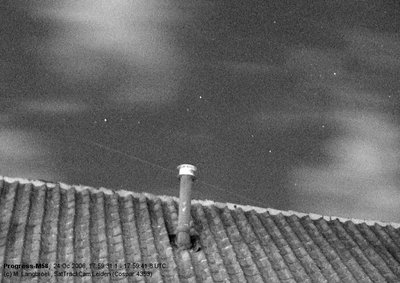
Yesterday evening I had dinner with Frans Rietmeijer, one of the Stardust scientists and an authority on IDP's. He is a personal friend and was in Holland for a.o. a Workshop. Over an Indonesian-Dutch "Rice table" he told me some interesting things about the preliminary mission results.
I observed it this evening under far from ideal circumstances: at an elevation of only 30-35 degrees, and seen through a hole in flying cloud cover, it crossed Aquila around 17:59:30 UTC just before it went into eclipse. It was very fast, at a steady magnitude +1.5.
Standing with my back pressed against the northern wall of the compound, looking south over the courtyard, I could see it grazing the roof of my house. Below is the photograph I obtained: maybe not quite spectacular, but I am glad I catched it at all. The start of the trail coincides with it clearing the roof edge! The image yielded 2 positions, with similar delta T (about +1.7s with regard to elsets then available).
Of course, a few minutes after this pass it was completely clear...
(click images to enlarge)


Yesterday evening I had dinner with Frans Rietmeijer, one of the Stardust scientists and an authority on IDP's. He is a personal friend and was in Holland for a.o. a Workshop. Over an Indonesian-Dutch "Rice table" he told me some interesting things about the preliminary mission results.
Tuesday, 17 October 2006
Clear skies
The sky over SatTrackCam Leiden was very clear yesterday evening. Alas, there were little good satellite passes.
The only target captured was Lacrosse 4 (00-047A, #26473). The image yielded only one position, as the start point was obscured by a corner of a protruding part of the roof (see below).

The only target captured was Lacrosse 4 (00-047A, #26473). The image yielded only one position, as the start point was obscured by a corner of a protruding part of the roof (see below).
(click image to enlarge)

Sunday, 15 October 2006
Hazy, Lacrosse 4 and Murphy
It cleared enough during the afternoon to make some tracking possible this evening. Yet conditions were far from good: much haze in the sky.
This was a bit bad day. I had stomach trouble, felt a bit moody, and Murphy struck with the first target of the evening.
That first target was Lacrosse 3 (97-064A, #25017). When I pressed the shutter release, the camera did not give the series of beeps it should give: I had forgotten to set the 10 second self-timer... The satellite trail is well-visible in the resulting exposure, but the timing of start and end are uncalibrated, so its useless for positions...
Next target half an hour later was Lacrosse 4 (00-047A, #26473) and there things went well. Got two good images as it passed through Draco into Umi. Four positions, showing the sat nicely on-time and on-track.
This was a bit bad day. I had stomach trouble, felt a bit moody, and Murphy struck with the first target of the evening.
That first target was Lacrosse 3 (97-064A, #25017). When I pressed the shutter release, the camera did not give the series of beeps it should give: I had forgotten to set the 10 second self-timer... The satellite trail is well-visible in the resulting exposure, but the timing of start and end are uncalibrated, so its useless for positions...
Next target half an hour later was Lacrosse 4 (00-047A, #26473) and there things went well. Got two good images as it passed through Draco into Umi. Four positions, showing the sat nicely on-time and on-track.
Saturday, 14 October 2006
Warning about the orbit constellation plots
Hmmm, having played a bit more with it, it is clear that WinOrsa does not quite plot artificial earth satellites at the correct geographic subsatellite points.
The relative orbital constellation as such seems reasonably okay though. I think it models only using gravity (its software for modelling solar system object orbits after all) and not drag, hence the satellites get plotted at wrong positions in their orbits .
So be careful with the 3D plots I recently posted. The relative orbit orientations seem okay, but the absolute positions of the satellites not.
Note added 16/10: WinOrsa author Pasquale Tricarico today confirmed me that only gravity is modelled and not (yet) drag. This will hopefully be included in a future release. That would be cool, as the 3D graphic output of the software is great.
The relative orbital constellation as such seems reasonably okay though. I think it models only using gravity (its software for modelling solar system object orbits after all) and not drag, hence the satellites get plotted at wrong positions in their orbits .
So be careful with the 3D plots I recently posted. The relative orbit orientations seem okay, but the absolute positions of the satellites not.
Note added 16/10: WinOrsa author Pasquale Tricarico today confirmed me that only gravity is modelled and not (yet) drag. This will hopefully be included in a future release. That would be cool, as the 3D graphic output of the software is great.
Thursday, 12 October 2006
Spysat orbital constellation plot: NOSS
Orbital constellation of the Naval Ocean Surveillance System (NOSS) satellites, duo's and trio's of satellites for tracking ocean shipping (more info here).
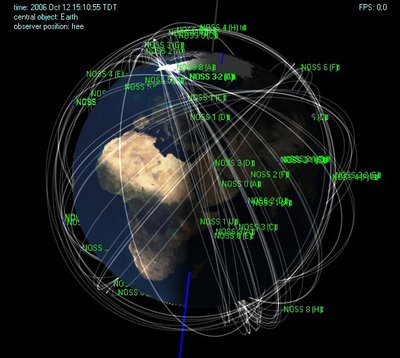

Wednesday, 11 October 2006
Coincidence, or clever Korean timing?
Coincidence, or clever timing by the North Koreans? When North Korea conducted its alledged atomic bomb test last Monday at 01:36 UTC, it almost seems as if they waited untill the test area was just outside the footprint of the Japanese IGS 1B, detonating it within minutes of it passing by.
IGS 1B (03-009B, #27699) is a Japanese high resolution radar reconnaissance satellite, one of the primary purposes of which is to keep an eye on North Korea.
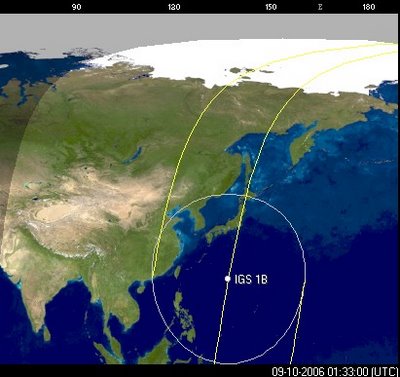
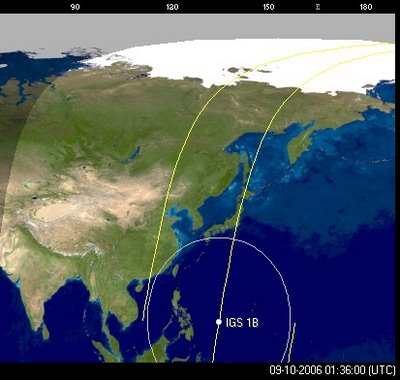
IGS 1B (03-009B, #27699) is a Japanese high resolution radar reconnaissance satellite, one of the primary purposes of which is to keep an eye on North Korea.


Tuesday, 10 October 2006
Some spysat orbital constellation plots (KH-12 Keyhole, Lacrosse and IGS)
Plots of the orbit constellations of the American KH-12 Keyhole optical imaging satellites and Lacrosse (Onyx) synthetic aperture radar satellites, and the Japanese IGS optical and radar satellites.
(see here for details on how the plots were made and additional plots)
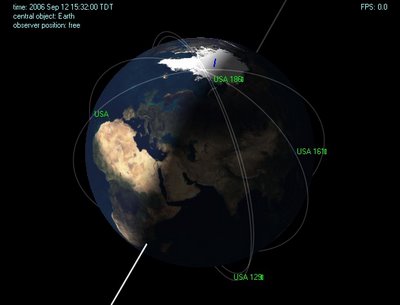
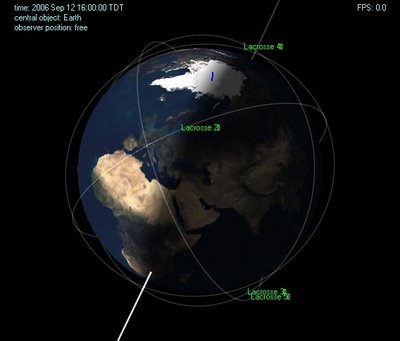

This plot shows how the IGS satellites keep an eye on North Korea:
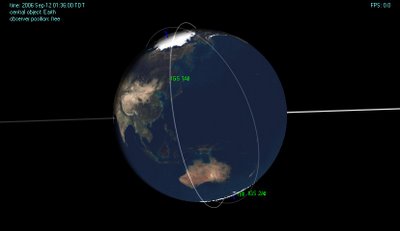
(see here for details on how the plots were made and additional plots)
(click images to enlarge)



This plot shows how the IGS satellites keep an eye on North Korea:
(click image to enlarge)

Picture fom last weekend
One of the pictures from last weekend, showing the trail of Lacrosse 5rk (05-016B, #28647), the still orbiting rocket stage of the Lacrosse 5 (05-016A) launch. The 'W' of Cassiopeia is well recognizable to the left of the trail (this, like all pictures on this blog, is a reduced resolution crop of part of the original image)
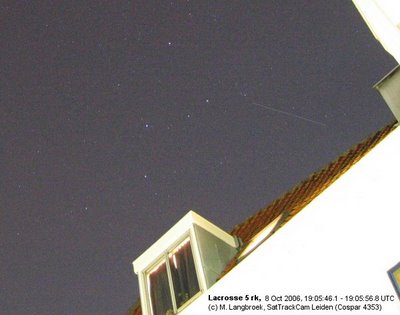
(click image to enlarge)

Sunday, 8 October 2006
Unexpected clear sky: Lacrosse 3 & Lacrosse 5rk
It rather unexpectedly cleared in the evening. Good transparent sky.
A first pass (18:34 UTC) of Lacrosse 3 (97-064A, #25017) was captured but the trail too faint to measure. More luck during the 20:14 UTC pass, when it was bright just before going into eclipse. Two points, on-time but perhaps slightly off-track (0.05-0.07 deg) with regard to elset 06278.76700984.
Got two pictures of Lacrosse 5rk (05-016B, #28647), hence 4 points, it was bright, nice pass. It was some 0.4 sec late and on-track with regard to elset 06277.75736727.
With a temperature of only 11 C outside, it was chilly.
A first pass (18:34 UTC) of Lacrosse 3 (97-064A, #25017) was captured but the trail too faint to measure. More luck during the 20:14 UTC pass, when it was bright just before going into eclipse. Two points, on-time but perhaps slightly off-track (0.05-0.07 deg) with regard to elset 06278.76700984.
Got two pictures of Lacrosse 5rk (05-016B, #28647), hence 4 points, it was bright, nice pass. It was some 0.4 sec late and on-track with regard to elset 06277.75736727.
With a temperature of only 11 C outside, it was chilly.
Quite a lot....
Below are two plots I constructed showing the orbits of all 170 amateur tracked classified objects (operational and defunct satellites and rocket boosters) from Mike McCant's classfd.tle. Quite a lot, isn't it?
The images were made with Pasquale Tricarico's WinOrsa orbit software

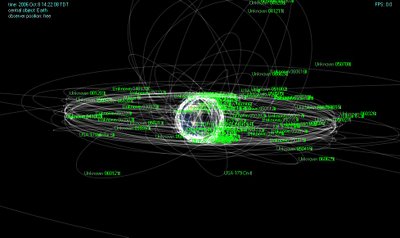
Update: some more plots of a few individual LEO sat orbit constellations here
The images were made with Pasquale Tricarico's WinOrsa orbit software
(click images to enlarge)


Update: some more plots of a few individual LEO sat orbit constellations here
Wednesday, 4 October 2006
Bad luck
I was having bad luck this evening, quite some bad luck... First, cloud cover prevented me from imaging the early passes of Lacrosse 2 & 3 and Lacrosse 5Rk. Then it cleared, but just as I pressed the trigger button to image the next pass of Lacrosse 3, the camera shut itself off due to a battery problem. Ten minutes later, clouds won the race for a patch of clear skies with Lacrosse 5Rk by a margin of only a minute. Damn.